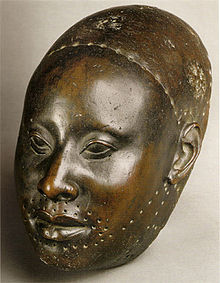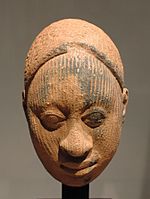| Revision as of 17:53, 16 November 2011 editUyvsdi (talk | contribs)Autopatrolled, Pending changes reviewers, Rollbackers34,032 editsm dab link← Previous edit | Revision as of 17:14, 22 August 2012 edit undoJohnbod (talk | contribs)Autopatrolled, Extended confirmed users, IP block exemptions, Rollbackers280,695 edits gallery from SculptureNext edit → | ||
| Line 1: | Line 1: | ||
| ] | ] | ||
| ]]] | |||
| The ] of South Western Africa (] Republic, ] and ], also including parts of ], ] and ]), have a very rich and vibrant artisan community, creating traditional and contemporary art.<ref>{{Cite web | url=http://www.africaresource.com/ijele/issue5/olajubu.html | title=The Place of Susanne Wenger's Art in Yoruba Religion | accessdate=2008-02-25}}</ref> The custom of art and artisans among the Yoruba is deeply rooted in the ] literary corpus, indicating the ]s Ogun, Obatala, Oshun and Obalufon as central to creation mythology including artistry (i.e. the art of humanity). | The ] of South Western Africa (] Republic, ] and ], also including parts of ], ] and ]), have a very rich and vibrant artisan community, creating traditional and contemporary art.<ref>{{Cite web | url=http://www.africaresource.com/ijele/issue5/olajubu.html | title=The Place of Susanne Wenger's Art in Yoruba Religion | accessdate=2008-02-25}}</ref> The custom of art and artisans among the Yoruba is deeply rooted in the ] literary corpus, indicating the ]s Ogun, Obatala, Oshun and Obalufon as central to creation mythology including artistry (i.e. the art of humanity). | ||
| Over the years, many have come to merge foreign ideas of artistry and contemporary art with the traditional art forms found in West Africa. | Over the years, many have come to merge foreign ideas of artistry and contemporary art with the traditional art forms found in West Africa. The traditional art forms among the Yoruba include but are not limited to: beading, braiding, tattooing, clay moulding and ceramic work, bronze casting, weaving and dyeing, sculpting, etc. | ||
| The traditional art forms among the Yoruba include but are not limited to: beading, braiding, tattooing, clay moulding and ceramic work, bronze casting, weaving and dyeing, sculpting, etc. | |||
| There is also a vibrant form of customary ] known as ''Alarinjo'' that has its roots in the medieval period and that has given much to the contemporary ]. | There is also a vibrant form of customary ] known as ''Alarinjo'' that has its roots in the medieval period and that has given much to the contemporary ]. | ||
| Line 13: | Line 11: | ||
| Metalworkers also create brass sculptures by ]. Brass is seen as being incorruptible by the ] Society.<ref name=smith/> | Metalworkers also create brass sculptures by ]. Brass is seen as being incorruptible by the ] Society.<ref name=smith/> | ||
| <gallery widths="200px" heights="200px" perrow="4"> | |||
| File:Ife sculpture Inv.A96-1-4.jpg|] head, ], probably 12–14th centuries | |||
| File:Ife Kings Head.jpg|Another head from ] from about the same time. | |||
| File:Africa Ife Head 1 Kimbell.jpg | |||
| File:Afrikaabteilung in Ethnological Museum Berlin 29.JPG|Sculpure of a 'Queen Mother' from Benin. | |||
| File:Edo ivory mask 18472.jpg|16th century ivory mask from Benin | |||
| File:Benin kingdom Louvre A97-4-1.jpg|One of the ], 16th-18th century, Nigeria. | |||
| </gallery> | |||
| ==References== | ==References== | ||
Revision as of 17:14, 22 August 2012

The Yoruba of South Western Africa (Benin Republic, Nigeria and Togo, also including parts of Ghana, Cameroon and Sierra Leone), have a very rich and vibrant artisan community, creating traditional and contemporary art. The custom of art and artisans among the Yoruba is deeply rooted in the Ifá literary corpus, indicating the orishas Ogun, Obatala, Oshun and Obalufon as central to creation mythology including artistry (i.e. the art of humanity).
Over the years, many have come to merge foreign ideas of artistry and contemporary art with the traditional art forms found in West Africa. The traditional art forms among the Yoruba include but are not limited to: beading, braiding, tattooing, clay moulding and ceramic work, bronze casting, weaving and dyeing, sculpting, etc.
There is also a vibrant form of customary theatre known as Alarinjo that has its roots in the medieval period and that has given much to the contemporary Nigerian film industry.
Metal arts
Yoruban blacksmiths create sculpture from iron, through hand-beating, welding, and casting. Ogun is honored as the god of iron.
Metalworkers also create brass sculptures by lost-wax casting. Brass is seen as being incorruptible by the Ogboni Society.
-
 Ife head, terracotta, probably 12–14th centuries
Ife head, terracotta, probably 12–14th centuries
-
 Another head from Ife from about the same time.
Another head from Ife from about the same time.
-

-
Sculpure of a 'Queen Mother' from Benin.
-
 16th century ivory mask from Benin
16th century ivory mask from Benin
-
 One of the Benin Bronzes, 16th-18th century, Nigeria.
One of the Benin Bronzes, 16th-18th century, Nigeria.
References
- "The Place of Susanne Wenger's Art in Yoruba Religion". Retrieved 2008-02-25.
- ^ "Shaping: The Blacksmith." Cutting to the Essence – Shaping for the Fire. 29 March 1995 (retrieved 15 Nov 2011)
External links
- Emodying the Sacred in Yoruba Art, Newark Museum
- Nigerian Traditional Arts, Crafts and Architecture
- Yoruban and Akan Art in Wood and Metal, Lakeview Museum of Arts and Sciences
| Yoruba religion (Orisa-Ifá) | |||||
|---|---|---|---|---|---|
| Spirits |
| ||||
| Countries of development | |||||
| Topics | |||||
| Sacred sites | |||||
| Legendary figures | |||||